Software Resilience w/ Circuit Breaker p.2
Hey there! It’s been a while..
Got caught up with some stuff which is a bad excuse but hey, here I am trying to get back at it again.
If you were anticipating the demo, here you go..
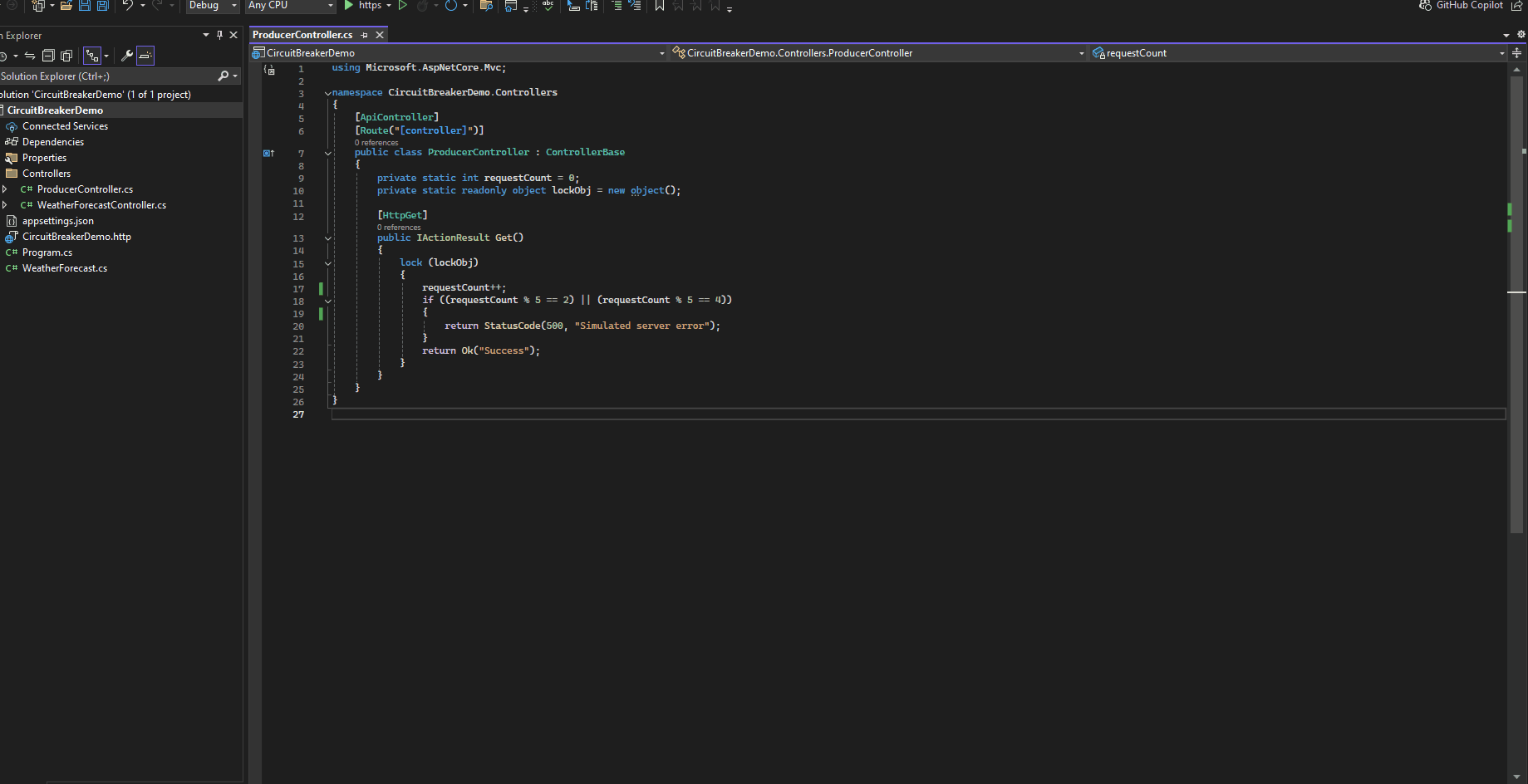
Now that you’ve caught a glimpse, let’s break it into these sections:
- Creating a simple demo api producer
- this will act as a third party api in your real world solution where it’s kindof flaky/faulty/unstable.
- Breakdown the circuit breaker implementation
Let’s get started!
Creating a simple demo api producer
First thing’s first.. Let’s create a blank web api project. (If you already know how to create one in either vs/vscode, you can keep scrolling.)
For my case, I prefer using Visual Studio rather than VS Code.
Step 1: Create a new project
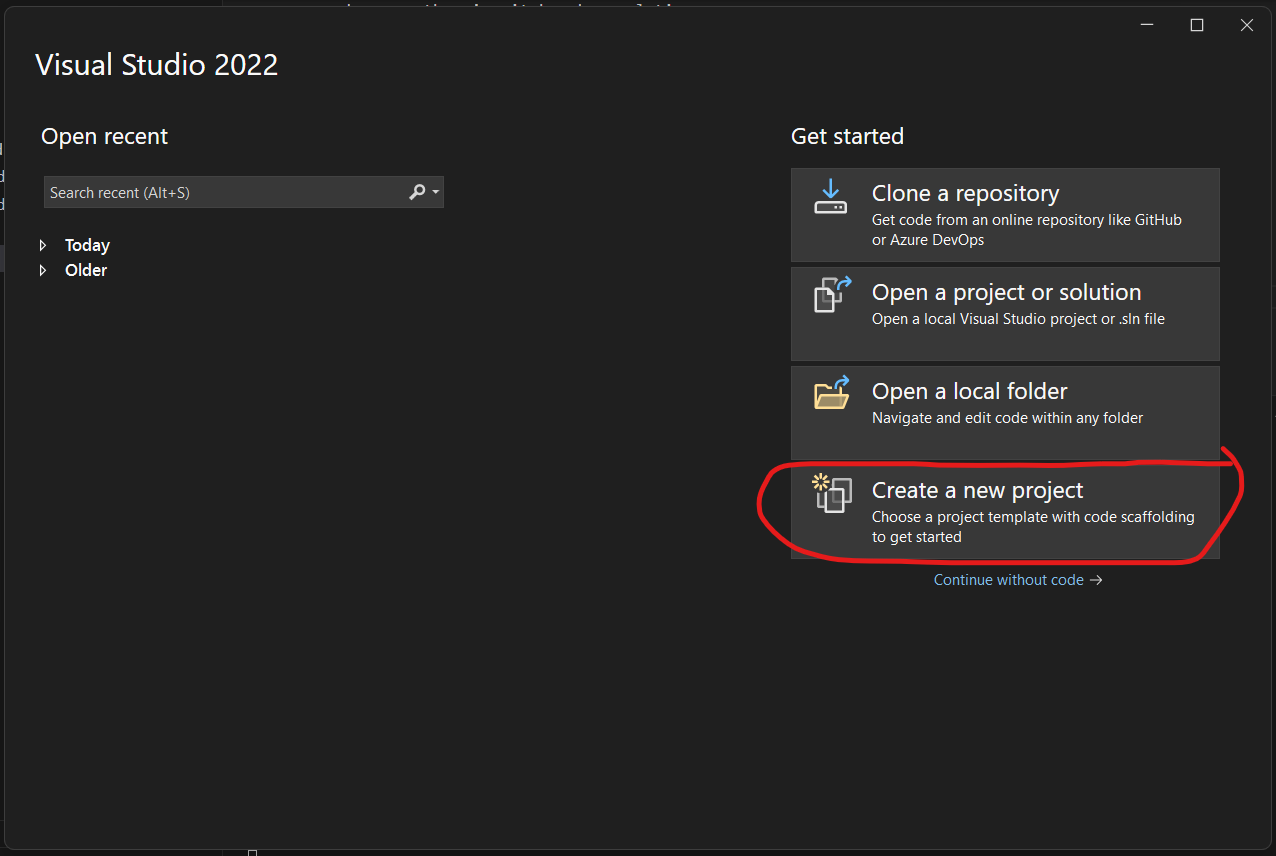
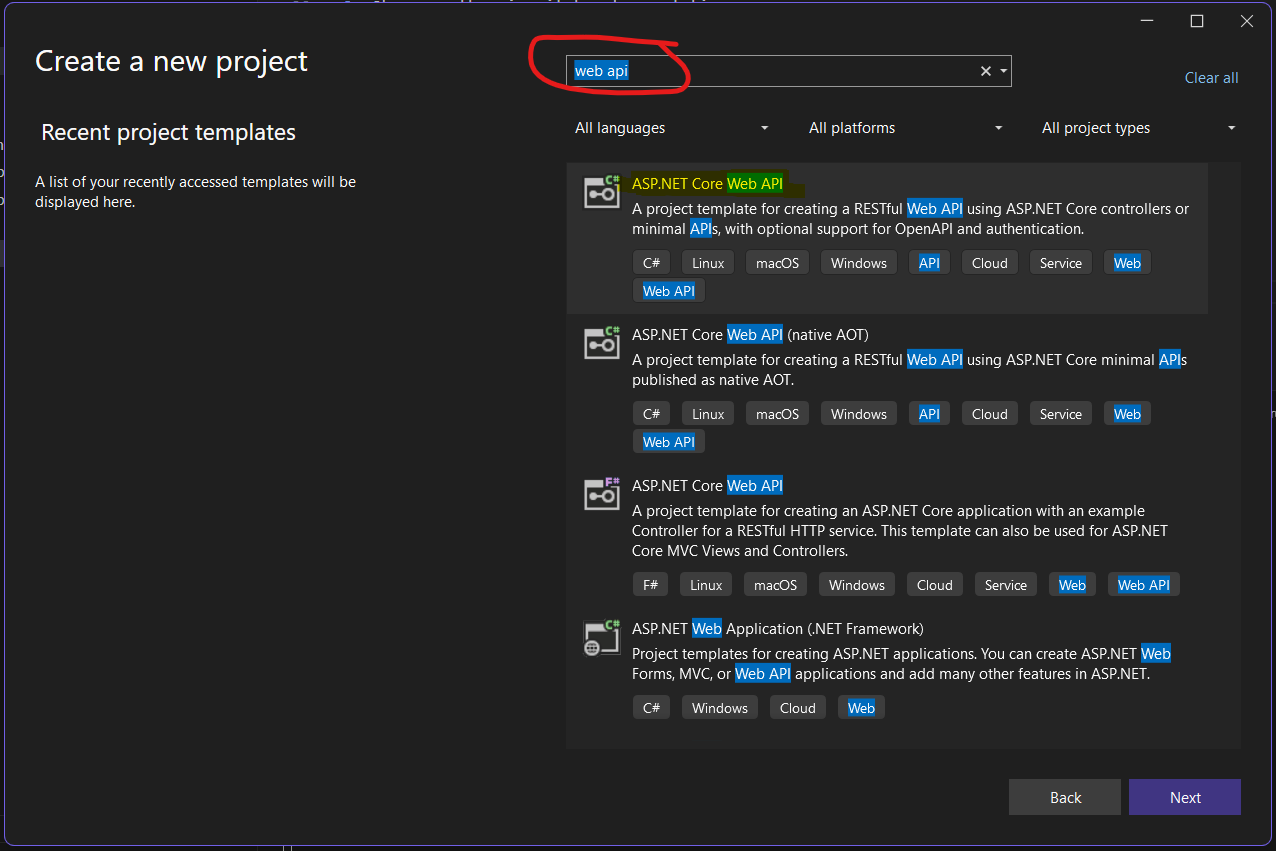
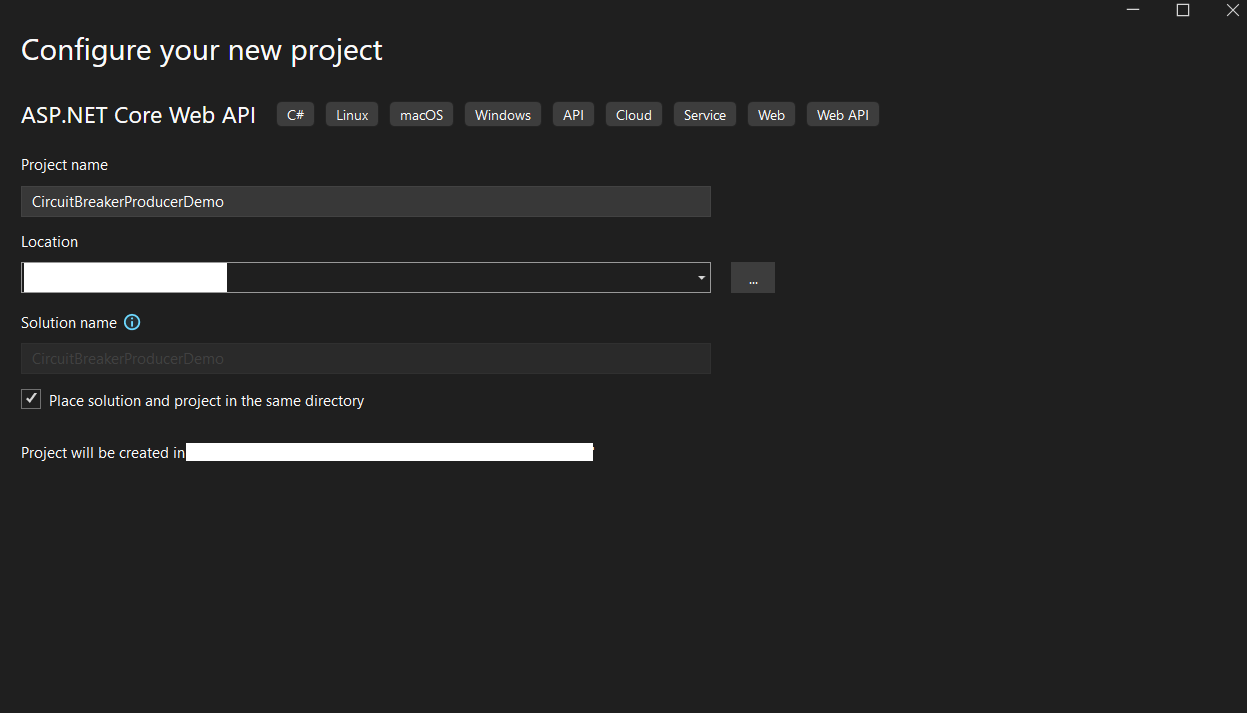
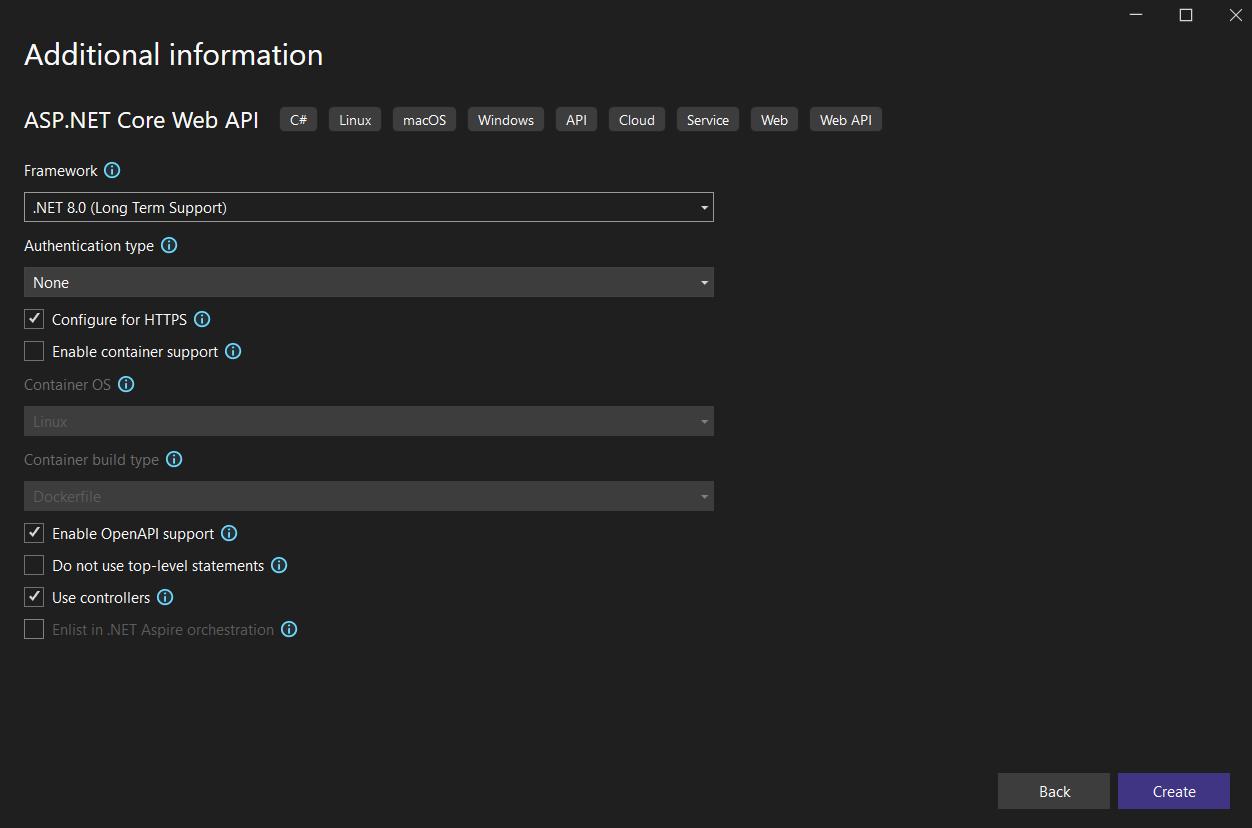
Step 2: Create a new controller

Add the code below:
using Microsoft.AspNetCore.Mvc;
namespace CircuitBreakerDemo.Controllers
{
[ApiController]
[Route("[controller]")]
public class ProducerController : ControllerBase
{
private static int requestCount = 0;
private static readonly object lockObj = new object();
[HttpGet]
public IActionResult Get()
{
lock (lockObj)
{
requestCount++;
if ((requestCount % 5 == 1) || (requestCount % 5 == 2))
{
return StatusCode(500, "Simulated server error");
}
return Ok("Success");
}
}
}
}
The code simulates a failure on the 2nd and 4th requests in every group of 5.
Now the fun part..
Breakdown the circuit breaker implementation
The first file we need to look at would be the PollyPolicy.
public class PollyPolicy
{
public readonly AsyncCircuitBreakerPolicy AsyncCircuitBreakerPolicy;
public readonly AsyncNoOpPolicy AsyncNoOpPolicy;
public PollyPolicy(IOptions<CircuitBreakerConfigurationSetings> optionsCircuitBreaker, ILogger<CircuitBreakerPolicy> logger)
{
var circuitBreakerSettings = optionsCircuitBreaker.Value;
AsyncCircuitBreakerPolicy = Policy
.Handle<ProviderException>()
.Or<GlobalTimeoutException>()
.AdvancedCircuitBreakerAsync(
failureThreshold: circuitBreakerSettings.FailureThreshold,
samplingDuration: TimeSpan.FromMilliseconds(circuitBreakerSettings.SamplingDuration),
minimumThroughput: circuitBreakerSettings.MinimumThroughput,
durationOfBreak: TimeSpan.FromMilliseconds(circuitBreakerSettings.DurationOfBreak),
onBreak: (exception, duration) =>
{
logger.LogError($"CIRCUIT_BREAKER_OPEN - Circuit breaker opened due to: {exception.Message}");
},
onHalfOpen: () =>
{
logger.LogWarning("CIRCUIT_BREAKER_HALF_OPEN - Circuit breaker is half-open.");
},
onReset: () =>
{
logger.LogInformation("CIRCUIT_BREAKER_CLOSED - Circuit breaker is closed.");
});
AsyncNoOpPolicy = Policy.NoOpAsync();
}
}
This provides a mechanism to apply a circuit breaker for handling certain failures (e.g. ProviderException, GlobalTimeoutException).
Let’s dig deeper.
Parameters:
- failureThreshold: this represents the percentage of action that must fail before the circuit breaker opens.
- samplingDuration: this is the time window over which the failure rate is measured.
- minimumThroughput: this is the minimum number of requests that must occur within the sampling duration for the circuit breaker to open.
- durationOfBreak: this defines how long the curcuit breaker remains open before it transitions to a half-open state to test if the underlying issue is resolved.
Actions:
- onBreak: the circuit breaker is open which means any incoming requests will immediately be rejected.
- onHalfOpen: the circuit breaker allows a limited number of requests to pass through to check if the issue has been resolved.
- onReset: the circuit breaker closes which assumes the underlying issue is resolved.
Quick one: Why do we need the circuit breaker to open?
- This is a protective measure designed to prevent further strain on a system that is already experiencing high failure rates. This is also to lessen if not avoid further administration issues from an operational standpoint.
Next, we look at the ResilientGlobalTimeoutAdapter.
public class ResilientGlobalTimeoutAdapter : IGlobalTimeoutAdapter
{
private readonly AsyncCircuitBreakerPolicy _asyncCircuitBreakerPolicy;
public ResilientGlobalTimeoutAdapter(PollyPolicy pollyPolicy)
{
_asyncCircuitBreakerPolicy = pollyPolicy.AsyncCircuitBreakerPolicy;
}
public async Task<T> ExecuteAsync<T>(Func<Task<T>> asyncMethod, CancellationToken cancellationToken)
{
return await _asyncCircuitBreakerPolicy.ExecuteAsync(() => ExecuteMethodAsync(asyncMethod, cancellationToken));
}
private async Task<T> ExecuteMethodAsync<T>(Func<Task<T>> asyncMethod, CancellationToken cancellationToken)
{
try
{
return await asyncMethod().WithCancellation(cancellationToken);
}
catch(OperationCanceledException operationCanceledException)
{
if (!cancellationToken.IsCancellationRequested)
throw new GlobalTimeoutException("HttpClient Timed out.", "HttpClient", operationCanceledException);
else
throw new GlobalTimeoutException("Global Timeout reached.", "ExecuteAsync", operationCanceledException);
}
}
}
This class acts as a resilience layer that applies the circuit breaker policy to protect asynchronous operations. If you noticed, the ProviderException isn’t thrown directly in this layer. This would be thrown by the service/method that ExecuteAsync represents.
Now, let’s just skim through the the implementation from the controller down to the service manager to the http client:
Controller:
This endpoint consumes the resilience layer we talked about.
[HttpPost]
public async Task<IActionResult> DoSomeStuff([FromBody] MockRequestDTO mockRequestDTO)
{
using (_logger.BeginScope(mockRequestDTO.MockRequestId ?? string.Empty))
{
var cancellationTokenSource = new CancellationTokenSource();
var token = cancellationTokenSource.Token;
try
{
if (!ModelState.IsValid)
{
_logger.LogWarning("Invalid model state for request: {@MockRequestDTO}", mockRequestDTO);
return BadRequest();
}
var mockResponseDTO = await _globalTimeoutAdapter.ExecuteAsync(() =>
_processStuffProcessorManager.DoSomeStuff(mockRequestDTO), token);
return Ok(new { ProviderCode = mockResponseDTO.ProviderCode });
}
catch (Exception ex)
{
_exceptionHandler.HandleException(ex, _logger);
return StatusCode(500, ex.Message);
}
}
}
Service Manager:
Ideally additional business logic is implemented on this side. For the demo, we just call the httpclient right away.
public async Task<MockResponseDTO> DoSomeStuff(MockRequestDTO responseDTO)
{
try
{
return await _sendRequestToExternalProviderHttpClient.SendRequestByMockRequest(responseDTO);
}
catch (Exception ex)
{
_exceptionHandler.HandleException(ex, _logger);
throw new ProviderException("HTTP Request failed.", "HttpClient", ex);
}
}
HttpClient:
Nothing fancy on the implementation below as this just consumes the Demo API producer that we created earlier.
public async Task<MockResponseDTO> SendRequestByMockRequest(MockRequestDTO mockRequestDTO)
{
if (mockRequestDTO is null)
throw new InvalidRequestException("MockRequestDTO should not be null.");
try
{
var request = Utility.BuildHttpRequest(_serviceUri, JsonConvert.SerializeObject(mockRequestDTO));
HttpResponseMessage response = await _httpClient.SendAsync(request);
response.EnsureSuccessStatusCode();
var content = await response.Content.ReadAsStringAsync();
return new MockResponseDTO
{
ProviderCode = content.Contains("Success", StringComparison.OrdinalIgnoreCase) ? "Success" : "ProviderError"
};
}
catch (Exception ex)
{
_exceptionHandler.HandleException(ex, _logger);
throw;
}
}
Lastly, let’s not forget to do our dependency injection which I forgot on my repository lol
public void ConfigureServices(IServiceCollection services)
{
services.AddMvc();
services.AddControllers();
services.AddLogging();
services.AddEndpointsApiExplorer();
services.AddSingleton<PollyPolicy>();
services.AddSwaggerGen();
services.AddTransient<IExceptionHandler, ExceptionHandler>();
services.AddTransient<IGlobalTimeoutAdapter, ResilientGlobalTimeoutAdapter>();
services.AddScoped<IHttpClientAdapter, HttpClientAdapter>();
services.AddHttpClient<ISendRequestToExternalProviderHttpClient, SendRequestToExternalProviderHHttpClient>();
services.AddTransient<IProcessStuffProcessorManager, ProcessStuffProcessorManager>();
services.AddOptions();
services.Configure<ExternalEndpointConfigurationSettings>(Configuration.GetSection("ExternalEndpointConfiguration"));
services.Configure<CircuitBreakerConfigurationSetings>(Configuration.GetSection("CircuitBreakerConfigurationSetings"));
}
That’s it. Easy. On to the next! :)